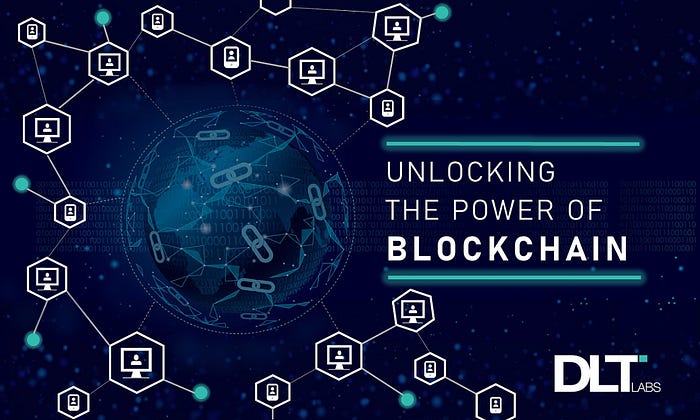What is Terraform and Where Does It Fit in the DevOps Process?
Why Blockchain-Based Cloud Computing Could Be the Future of IoT
With the adoption of IoT in more devices, it is also possible that data security threats such as hacking and data breaching increase significantly. So, to protect the IoT trending technology against such issues, blockchain technology comes into the picture. Blockchain networks are known to be more secure, cryptic, and reliable in terms of securing and keeping data safe. Thus, blockchain technology is also expanding along with the IoT to keep it safe. Generally, IoT is crucial to provide users a centralized network of devices. For instance, this centralized network is important to control home appliances, security sensors, or network adapters. Now, the IoT controller sends and receives the data from these devices to enable the wireless connection system. Currently, brands such as Samsung are manufacturing smart home appliances like air conditioners that can be connected to a simple mobile application. Moreover, Google’s Home device is also capable of controlling multiple devices with the voice command only.EXCLUSIVE Microsoft warns thousands of cloud customers of exposed databases
/cloudfront-us-east-2.images.arcpublishing.com/reuters/N45WXQTJYFIIBNBHNKPEHHVXO4.jpg) The vulnerability is in Microsoft Azure's flagship Cosmos DB database. A
research team at security company Wiz discovered it was able to access keys that
control access to databases held by thousands of companies. Wiz Chief Technology
Officer Ami Luttwak is a former chief technology officer at Microsoft's Cloud
Security Group. Because Microsoft cannot change those keys by itself, it emailed
the customers Thursday telling them to create new ones. Microsoft agreed to pay
Wiz $40,000 for finding the flaw and reporting it, according to an email it sent
to Wiz. "We fixed this issue immediately to keep our customers safe and
protected. We thank the security researchers for working under coordinated
vulnerability disclosure," Microsoft told Reuters. Microsoft's email to
customers said there was no evidence the flaw had been exploited. "We have no
indication that external entities outside the researcher (Wiz) had access to the
primary read-write key," the email said. “This is the worst cloud vulnerability
you can imagine. It is a long-lasting secret,” Luttwak told Reuters.
The vulnerability is in Microsoft Azure's flagship Cosmos DB database. A
research team at security company Wiz discovered it was able to access keys that
control access to databases held by thousands of companies. Wiz Chief Technology
Officer Ami Luttwak is a former chief technology officer at Microsoft's Cloud
Security Group. Because Microsoft cannot change those keys by itself, it emailed
the customers Thursday telling them to create new ones. Microsoft agreed to pay
Wiz $40,000 for finding the flaw and reporting it, according to an email it sent
to Wiz. "We fixed this issue immediately to keep our customers safe and
protected. We thank the security researchers for working under coordinated
vulnerability disclosure," Microsoft told Reuters. Microsoft's email to
customers said there was no evidence the flaw had been exploited. "We have no
indication that external entities outside the researcher (Wiz) had access to the
primary read-write key," the email said. “This is the worst cloud vulnerability
you can imagine. It is a long-lasting secret,” Luttwak told Reuters. Linux 5.14 set to boost future enterprise application security
One of the ways that Linux users have had to mitigate those vulnerabilities is by disabling hyper-threading on CPUs and therefore taking a performance hit. “More specifically, the feature helps to split trusted and untrusted tasks so that they don’t share a core, limiting the overall threat surface while keeping cloud-scale performance relatively unchanged,” McGrath explained. Another area of security innovation in Linux 5.14 is a feature that has been in development for over a year and a half that will help to protect system memory in a better way than before. Attacks against Linux and other operating systems often target memory as a primary attack surface to exploit. With the new kernel, there is a capability known as memfd_secret () that will enable an application running on a Linux system to create a memory range that is inaccessible to anyone else, including the kernel. “This means cryptographic keys, sensitive data and other secrets can be stored there to limit exposure to other users or system activities,” McGrath said.4 Reasons Why Every Data Scientist Should Study Organizational Psychology
 As data scientists we need to understand the psychology of our data sets in
order to work with data effectively. We also need to motivate ourselves and
others so that everyone is doing what it takes to deliver results on time and
under budget. You might be a team leader or an executive that lead a data
science team. There are many data science roles that require someone to lead
others. If you are a data scientist in this role, understanding the psychology
of your data scientists is essential for success as a team leader and executive.
Organizational psychologists study topics such as leadership styles, group
dynamics, motivation, and conflict resolution — all of which are important for
any data scientist looking to lead a team. Setting well defined goals that your
direct reports understand and allowing them to take ownership of their work are
examples of strong leadership. Thus having a deeper understanding these
psychology based concepts and putting them to use for your daily work would
result in much more productive and having a more fulfilling work experience for
you and the team.
As data scientists we need to understand the psychology of our data sets in
order to work with data effectively. We also need to motivate ourselves and
others so that everyone is doing what it takes to deliver results on time and
under budget. You might be a team leader or an executive that lead a data
science team. There are many data science roles that require someone to lead
others. If you are a data scientist in this role, understanding the psychology
of your data scientists is essential for success as a team leader and executive.
Organizational psychologists study topics such as leadership styles, group
dynamics, motivation, and conflict resolution — all of which are important for
any data scientist looking to lead a team. Setting well defined goals that your
direct reports understand and allowing them to take ownership of their work are
examples of strong leadership. Thus having a deeper understanding these
psychology based concepts and putting them to use for your daily work would
result in much more productive and having a more fulfilling work experience for
you and the team.5 keys that define leaders in a storm
 There is no one who is invulnerable, and we all have a point that, when touched,
takes us to that state where the most sensitive fibers appear. As much as you
see leaders who show themselves to be powerful and almost indestructible, I work
permanently with those people who, in intimacy with themselves, are exactly the
same as any other. To work on accepting vulnerability: self-awareness, knowing
who you are and being encouraged to go deep into diving into your inner aspects
are the best tools. By doing so, you will strengthen your confidence and you
will also know how to allow yourself the moments where it is not necessary to
force yourself to be someone you are not and simply swim in your emotions,
without repressing or hiding them. Limiting tendencies are accepted behaviors
that you have about your emotional world. They feed on restrictive beliefs that,
by making them true in yourself, you assume them as natural and real. Limiting
tendencies are made up of a range of triggers against which you act
automatically, which manifest themselves in the form of reactions that always
lead you down the same path.
There is no one who is invulnerable, and we all have a point that, when touched,
takes us to that state where the most sensitive fibers appear. As much as you
see leaders who show themselves to be powerful and almost indestructible, I work
permanently with those people who, in intimacy with themselves, are exactly the
same as any other. To work on accepting vulnerability: self-awareness, knowing
who you are and being encouraged to go deep into diving into your inner aspects
are the best tools. By doing so, you will strengthen your confidence and you
will also know how to allow yourself the moments where it is not necessary to
force yourself to be someone you are not and simply swim in your emotions,
without repressing or hiding them. Limiting tendencies are accepted behaviors
that you have about your emotional world. They feed on restrictive beliefs that,
by making them true in yourself, you assume them as natural and real. Limiting
tendencies are made up of a range of triggers against which you act
automatically, which manifest themselves in the form of reactions that always
lead you down the same path.Quantum computers could read all your encrypted data. This 'quantum-safe' VPN aims to stop that
 In other words, encryption protocols as we know them are essentially a huge math
problem for hackers to solve. With existing computers, cracking the equation is
extremely difficult, which is why VPNs, for now, are still a secure solution.
But quantum computers are expected to bring about huge amounts of extra
computing power – and with that, the ability to hack any cryptography key in
minutes. "A lot of secure communications rely on algorithms which have been very
successful in offering secure cryptography keys for decades," Venkata Josyula,
the director of technology at Verizon, tells ZDNet. "But there is enough
research out there saying that these can be broken when there is a quantum
computer available at a certain capacity. When that is available, you want to be
protecting your entire VPN infrastructure." One approach that researchers are
working on consists of developing algorithms that can generate keys that are too
difficult to hack, even with a quantum computer. This area of research is known
as post-quantum cryptography, and is particularly sought after by governments
around the world.
In other words, encryption protocols as we know them are essentially a huge math
problem for hackers to solve. With existing computers, cracking the equation is
extremely difficult, which is why VPNs, for now, are still a secure solution.
But quantum computers are expected to bring about huge amounts of extra
computing power – and with that, the ability to hack any cryptography key in
minutes. "A lot of secure communications rely on algorithms which have been very
successful in offering secure cryptography keys for decades," Venkata Josyula,
the director of technology at Verizon, tells ZDNet. "But there is enough
research out there saying that these can be broken when there is a quantum
computer available at a certain capacity. When that is available, you want to be
protecting your entire VPN infrastructure." One approach that researchers are
working on consists of developing algorithms that can generate keys that are too
difficult to hack, even with a quantum computer. This area of research is known
as post-quantum cryptography, and is particularly sought after by governments
around the world. Essential Skills Every Aspiring Cyber Security Professional Should Have
 As a cybersecurity professional, your job will revolve around technology and its
many applications, regardless of the position you’re going to fill. Therefore, a
strong understanding of the systems, networks, and software you’re going to work
with is crucial for landing a good job in the field. Cybersecurity is an
extremely complex domain, with many sub-disciplines, which means it’s virtually
impossible to be an expert in all areas. That’s why you should choose a
specialization and strive to assimilate as much knowledge and experience as
possible in your specific area of activity. Earning a certificate of
specialization is a good starting point. It’s good to have a general knowledge
of other areas of cybersecurity, but instead of becoming a jack of all trades,
you should focus on your specific domain if you want to increase your chances of
success. Cybersecurity is all about protecting the company or organization you
work for against potential cyber threats. This implies identifying
vulnerabilities, improving security policies and protocols, eliminating
cybersecurity risks, minimizing damages after an attack and constantly coming up
with new solutions to avoid similar issues from happening again.
As a cybersecurity professional, your job will revolve around technology and its
many applications, regardless of the position you’re going to fill. Therefore, a
strong understanding of the systems, networks, and software you’re going to work
with is crucial for landing a good job in the field. Cybersecurity is an
extremely complex domain, with many sub-disciplines, which means it’s virtually
impossible to be an expert in all areas. That’s why you should choose a
specialization and strive to assimilate as much knowledge and experience as
possible in your specific area of activity. Earning a certificate of
specialization is a good starting point. It’s good to have a general knowledge
of other areas of cybersecurity, but instead of becoming a jack of all trades,
you should focus on your specific domain if you want to increase your chances of
success. Cybersecurity is all about protecting the company or organization you
work for against potential cyber threats. This implies identifying
vulnerabilities, improving security policies and protocols, eliminating
cybersecurity risks, minimizing damages after an attack and constantly coming up
with new solutions to avoid similar issues from happening again.The Surprising History of Distributed Ledger Technology
 The concept of a distributed ledger can be traced back as far as the times of
the Roman Empire. As is now, the problem was how to achieve consensus on the
data in a decentralized, distributed, and trustless manner. This problem is
described as the Byzantine Generals’ Problem. The Byzantine Generals’ problem
describes a scenario where a general plans to launch an attack. However, since
the army is very dispersed, he or she does not have centralized control. The
only way to succeed is if the Byzantine army launches a planned and synchronized
attack, where any miscommunication can cause the offence to fail. The only way
that the generals can synchronize a strike is by sending messages via
messengers, which leads to several failure scenarios where different actors in
the system behave dishonestly. Bitcoin solved the Byzantine Generals’ Problem by
providing a unified protocol, called proof of work. The Generals problem
described the main obstacle to massive, distributed processing and is the
foundation for distributed ledger technology, where everyone must work
individually to maintain a synchronized and distributed ledger.
The concept of a distributed ledger can be traced back as far as the times of
the Roman Empire. As is now, the problem was how to achieve consensus on the
data in a decentralized, distributed, and trustless manner. This problem is
described as the Byzantine Generals’ Problem. The Byzantine Generals’ problem
describes a scenario where a general plans to launch an attack. However, since
the army is very dispersed, he or she does not have centralized control. The
only way to succeed is if the Byzantine army launches a planned and synchronized
attack, where any miscommunication can cause the offence to fail. The only way
that the generals can synchronize a strike is by sending messages via
messengers, which leads to several failure scenarios where different actors in
the system behave dishonestly. Bitcoin solved the Byzantine Generals’ Problem by
providing a unified protocol, called proof of work. The Generals problem
described the main obstacle to massive, distributed processing and is the
foundation for distributed ledger technology, where everyone must work
individually to maintain a synchronized and distributed ledger.The trouble with tools - Overcoming the frustration of failed data governance technologies
 To explain, inside many organizations that claim to focus on data governance,
the process is reliant on tools that produce a CSV of objects with no insight
about where violations might exist. For example, they struggle to tell the
difference between Personal Information (PI) and Personal Identifiable
Information (PII). While most PI data doesn’t identify a specific person and
isn’t as relevant to identifying governance violations, discovery tools still
present that information to users, adding huge complexity to their processes and
forcing them to revert to a manual process to filter what’s needed from what
isn’t. Instead, it’s critical that organizations are able to view, classify and
correlate data wherever it is stored, and do so from a single platform -
otherwise, they simply can’t add value to the governance process. In the ideal
scenario, effective governance tools will enable organizations to correlate
their governance processes across all data sources to show where PII is being
held, for example. The outputs then become much more accurate, so in a scenario
where there are 10 million findings, users know with precision which of them are
PII.
To explain, inside many organizations that claim to focus on data governance,
the process is reliant on tools that produce a CSV of objects with no insight
about where violations might exist. For example, they struggle to tell the
difference between Personal Information (PI) and Personal Identifiable
Information (PII). While most PI data doesn’t identify a specific person and
isn’t as relevant to identifying governance violations, discovery tools still
present that information to users, adding huge complexity to their processes and
forcing them to revert to a manual process to filter what’s needed from what
isn’t. Instead, it’s critical that organizations are able to view, classify and
correlate data wherever it is stored, and do so from a single platform -
otherwise, they simply can’t add value to the governance process. In the ideal
scenario, effective governance tools will enable organizations to correlate
their governance processes across all data sources to show where PII is being
held, for example. The outputs then become much more accurate, so in a scenario
where there are 10 million findings, users know with precision which of them are
PII.Quote for the day:
"It is the responsibility of leadership to provide opportunity, and the responsibility of individuals to contribute." -- William Pollard
No comments:
Post a Comment